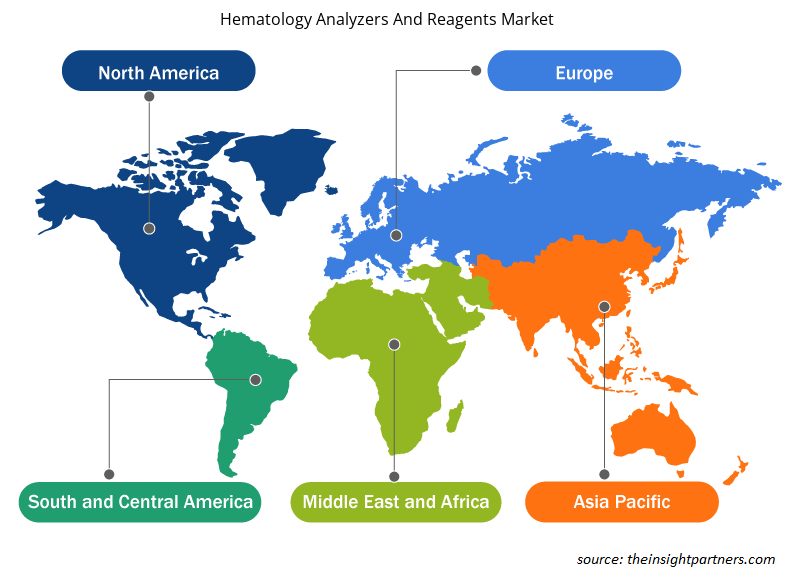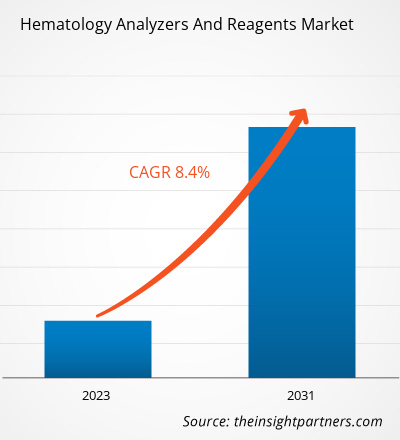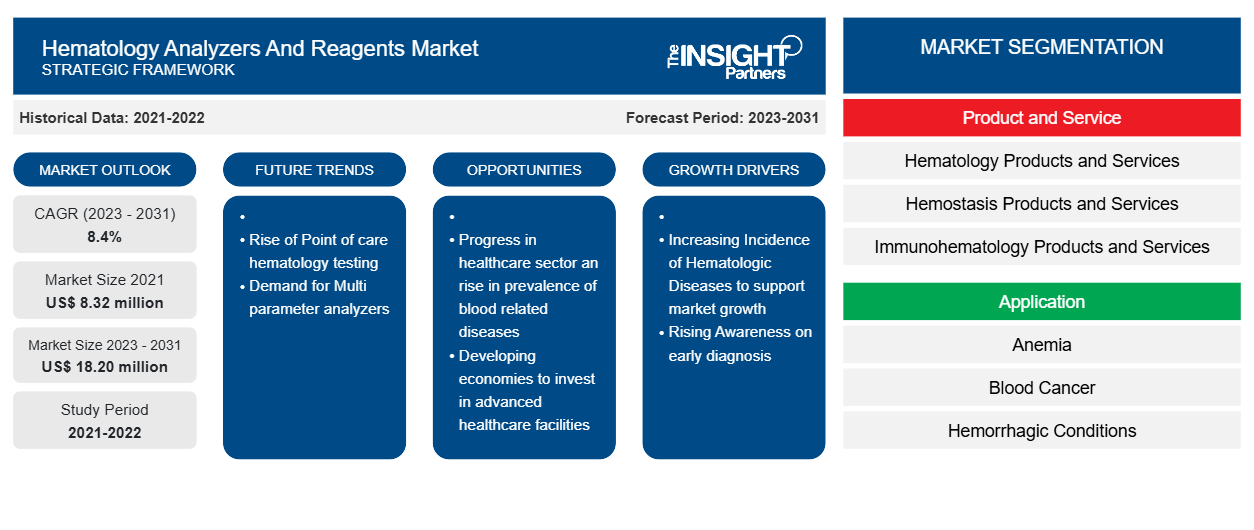血液学分析仪和试剂市场规模预计在 2021 年为 832 万美元,在 2023 年为 XX 万美元,预计到 2031 年将达到 1820 万美元;预计到 2031 年的复合年增长率为 8.4%。智能即时诊断设备的采用率不断提高可能仍是血液学分析仪和试剂市场的主要趋势。
血液分析仪和试剂市场分析
血液学分析仪和试剂市场的参与者竞争非常激烈,并且一直在推出新产品和试剂。例如,2024 年 1 月,HORIBA Medical 推出了最新的 HELO 2.0 高通量自动化血液学平台。该平台已获得 CE-欧洲体外诊断设备法规 (IVDR) 批准,目前正在等待美国食品药品监督管理局 (FDA) 的批准。HELO 2.0 是下一代高端血液学系列,是与客户协商开发的,可满足所有高通量全自动血液学需求。HELO 2.0 提供了高度灵活和高效的模块化血液学解决方案,可以完全扩展和配置,以满足中型到大型实验室的不同需求。同样,2023 年 5 月,西门子医疗推出了两种用于大容量血液学测试的解决方案:Atellica HEMA 570 分析仪和 Atellica HEMA 580 分析仪。由于 CBC 检测的广泛使用和人员短缺问题日益严重,实验室快速审查和发布患者检测结果的能力受到阻碍。Atellica HEMA 570 和 Atellica HEMA 580 分析仪提供集成自动化和智能功能,可提高工作流程效率并更快地生成患者结果。此类新产品的推出推动了血液学分析仪和试剂市场的增长。
血液分析仪和试剂市场概览
血液分析仪和试剂市场的增长归因于血液病数量的增加和血液分析仪技术的进步。然而,高端系统高昂的价格可能会阻碍市场的增长。
全球血液分析仪和试剂市场按地区划分为北美、欧洲、亚太、中东和非洲以及南美和中美。北美地区是血液分析仪和试剂的最大股东,亚太地区是增长最快的市场。血液分析仪和试剂市场的增长预计在美国占最大份额。由于血液检测程序数量增加、血液病患病率高、诊断和血液检测中心数量增加、以及可以使用完善的基础设施等,预计美国市场的增长将有所增长。
定制此报告以满足您的需求
您可以免费定制任何报告,包括本报告的部分内容、国家级分析、Excel 数据包,以及为初创企业和大学提供优惠和折扣
-
获取此报告的关键市场趋势。这个免费样品将包括数据分析,从市场趋势到估计和预测。
血液分析仪和试剂市场驱动因素和机遇
血液病发病率上升利好市场
根据美国疾病控制与预防中心 (CDC) 的数据,美国每 100,000 名男性中约有 12 名患有血友病 A,每年有 400 名男孩出生时患有血友病 A。此外,白血病和淋巴瘤协会 (LLS) 报告称,在美国,每 3 分钟就有一人被诊断出患有淋巴瘤、白血病或骨髓瘤。预计到 2023 年,美国将有 184,720 人被诊断出患有白血病、淋巴瘤或骨髓瘤。此外,预计淋巴瘤、白血病和骨髓瘤新病例将占 2023 年美国新诊断的 1,958,310 例癌症病例的 9.4%。血液病患病率的上升增加了对输血以及用于监测正常情况的血细胞计数的需求,这进一步增加了对血液分析仪和试剂的需求。血液相关疾病发病率的不断上升促进了血液分析仪和试剂市场的增长。
新兴经济体医疗保健领域的进步和血液相关疾病患病率的上升——血液分析仪和试剂市场的机会
由于人口生活方式的转变,发展中国家血液病的发病率正在大幅上升。此外,由于体力活动减少和压力水平增加导致其他健康状况的患病率激增,也导致这些国家血液病病例的增加。发展中国家正在努力在医疗设施和服务方面取得重大进步。例如,印度血友病联合会 (HFI) 是一个非营利组织,它与世界血友病联合会 (WFH) 密切合作,以提高人们对血友病的认识和可负担的血友病治疗方法,并提高对该病的诊断能力。此外,RED LAPI 专业团队致力于为拉丁美洲的血友病诊断和治疗做出贡献并改善其治疗。亚太、中东和非洲以及拉丁美洲发展中国家血液分析仪和试剂市场的这种发展为市场参与者的未来增长提供了机会。
血液分析仪和试剂市场报告细分分析
促成血液学分析仪和试剂市场分析的关键部分是产品和服务、原因、应用和最终用户。
- 根据产品和服务,血液学分析仪和试剂市场细分为血液学产品和服务、止血产品和服务以及免疫血液学产品和服务。血液学产品和服务进一步细分为仪器、试剂和耗材以及服务。同样,止血产品和服务部分进一步细分为仪器、试剂和耗材以及服务。血液学分析仪和试剂市场的免疫血液学产品和服务部分也进一步细分为仪器、试剂和耗材以及服务。血液学产品和服务部分在 2023 年占有更大的市场份额。
- 根据应用,市场细分为贫血、血癌、出血性疾病、感染相关疾病、免疫系统相关疾病和其他应用。贫血领域在 2023 年占据了最大的市场份额。
- 就最终用户而言,市场分为医院实验室、商业服务提供商、政府参考实验室以及研究和学术机构。医院实验室部门在 2023 年占据了市场主导地位。
血液学分析仪和试剂市场份额按地区分析
血液分析仪和试剂市场报告的地理范围主要分为五个区域:北美、亚太、欧洲、中东和非洲、南美/南美和中美。
在北美,美国是血液分析仪和试剂制造的最大市场。美国市场的增长主要受到有利的研究前景、对血液和血液成分的需求不断增长以及自动化血液学仪器的广泛采用的推动。
在美国,白血病、血友病和贫血等血液病的发病率不断上升。美国癌症协会对 2024 年美国白血病的估计如下:
- 约有 62,770 例新发白血病病例(所有类型)和 23,670 例因白血病(所有类型)死亡的病例
- 约有 20,800 例急性髓系白血病 (AML) 新病例。大多数为成年人。
- 约有 11,220 人死于 AML。几乎所有患者都是成年人。
患者对早期诊断意识的提高有望成为血液分析仪和试剂市场的主要推动力之一。预计亚太地区将在未来几年以最高的复合年增长率增长。
血液学分析仪和试剂市场区域洞察
Insight Partners 的分析师已详尽解释了预测期内影响血液分析仪和试剂市场的区域趋势和因素。本节还讨论了北美、欧洲、亚太地区、中东和非洲以及南美和中美洲的血液分析仪和试剂市场细分和地理位置。

- 获取血液学分析仪和试剂市场的区域特定数据
血液学分析仪和试剂市场报告范围
| 报告属性 | 细节 |
|---|---|
| 2021 年市场规模 | 832万美元 |
| 2031 年市场规模 | 1,820万美元 |
| 全球复合年增长率(2023 - 2031) | 8.4% |
| 史料 | 2021-2022 |
| 预测期 | 2023-2031 |
| 涵盖的领域 |
按产品和服务
|
| 覆盖地区和国家 |
北美
|
| 市场领导者和主要公司简介 |
|
血液学分析仪和试剂市场参与者密度:了解其对业务动态的影响
血液分析仪和试剂市场正在快速增长,这得益于终端用户需求的不断增长,而这些需求又源于消费者偏好的不断变化、技术进步以及对产品优势的认识不断提高等因素。随着需求的增加,企业正在扩大其产品范围,进行创新以满足消费者的需求,并利用新兴趋势,从而进一步推动市场增长。
市场参与者密度是指在特定市场或行业内运营的企业或公司的分布情况。它表明在给定市场空间中,相对于其规模或总市场价值,有多少竞争对手(市场参与者)存在。
在血液学分析仪和试剂市场运营的主要公司有:
- 临床诊断解决方案有限公司
- 深圳迈瑞生物医疗电子股份有限公司
- 丹纳赫
- BIO-RAD 实验室公司
- 雅培
- 迪亚特龙
免责声明:上面列出的公司没有按照任何特定顺序排列。

- 了解血液学分析仪和试剂市场的主要参与者概况
血液学分析仪和试剂市场新闻和最新发展
血液分析仪和试剂市场通过收集一级和二级研究后的定性和定量数据进行评估,其中包括重要的公司出版物、协会数据和数据库。以下是血液分析仪和试剂市场的发展和策略列表:
- HORIBA Medical 推出了其 Yumizen 血液学产品系列的新产品。该公司推出了两款紧凑型台式血液学分析仪 Yumizen H500 和 Yumizen H550,它们具有增强的性能、新功能和更多优势。这些分析仪旨在提供快速而全面的血液学报告,具有每小时 60 次测试的高吞吐量、40 个试管的自主性以及连续加载、紧急手动模式以及多分析模式和运行样本的采样。(来源:HORIBA Medical,2022 年)
- 迈瑞推出了革命性的血液分析仪系列 BC-700 系列,该系列结合了全血细胞计数 (CBC) 和红细胞沉降率 (ESR) 测试。该系列包括两种开放式样品瓶型号 BC-700/BC-720 和两种自动装载机型号 BC-760/BC-780。该系列旨在为中等容量实验室提供应用于高端产品的先进诊断技术。(来源:深圳迈瑞生物医疗电子股份有限公司,新闻稿,2022 年)
血液学分析仪和试剂市场报告覆盖范围和交付成果
“血液学分析仪和试剂市场规模和预测(2021-2031)”报告对以下领域进行了详细的市场分析:
- 范围内所有主要细分市场的全球、区域和国家层面的市场规模和预测
- 市场动态,如驱动因素、限制因素和关键机遇
- 未来主要趋势
- 详细的 PEST/波特五力分析和 SWOT 分析
- 全球和区域市场分析涵盖关键市场趋势、主要参与者、法规和最新市场发展
- 行业格局和竞争分析,涵盖市场集中度、热点图分析、知名参与者和最新发展
- 详细的公司简介
- 历史分析(2 年)、基准年、预测(7 年)及复合年增长率
- PEST和SWOT分析
- 市场规模、价值/数量 - 全球、区域、国家
- 行业和竞争格局
- Excel 数据集
近期报告
客户评价
购买理由
- 明智的决策
- 了解市场动态
- 竞争分析
- 客户洞察
- 市场预测
- 风险规避
- 战略规划
- 投资论证
- 识别新兴市场
- 优化营销策略
- 提升运营效率
- 顺应监管趋势























 获取免费样品 - 血液学分析仪和试剂市场
获取免费样品 - 血液学分析仪和试剂市场